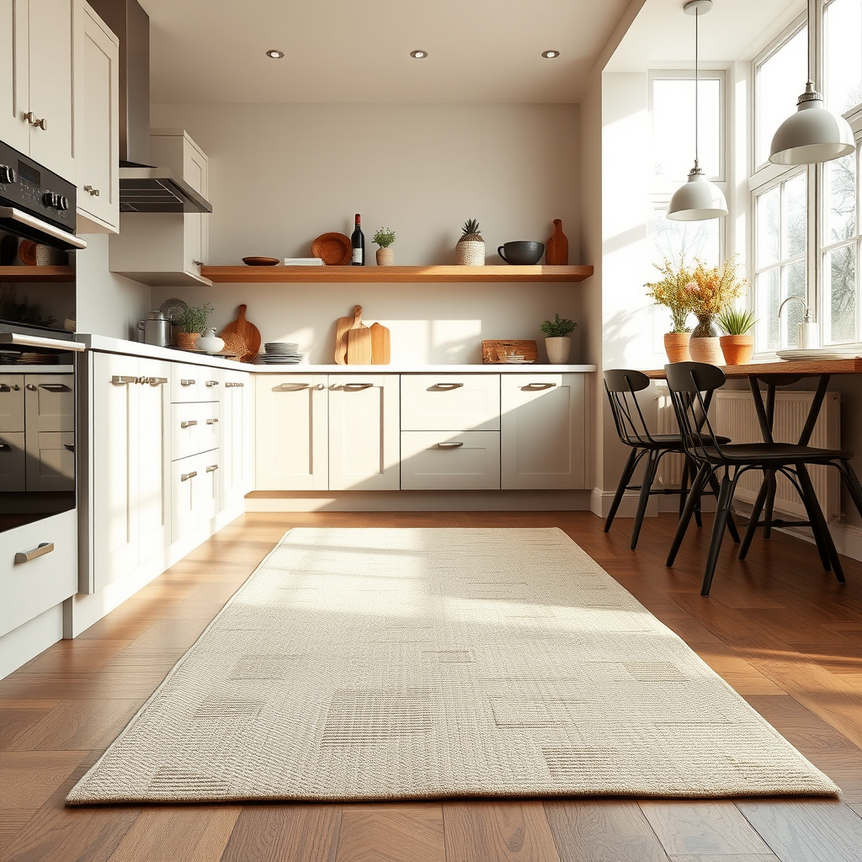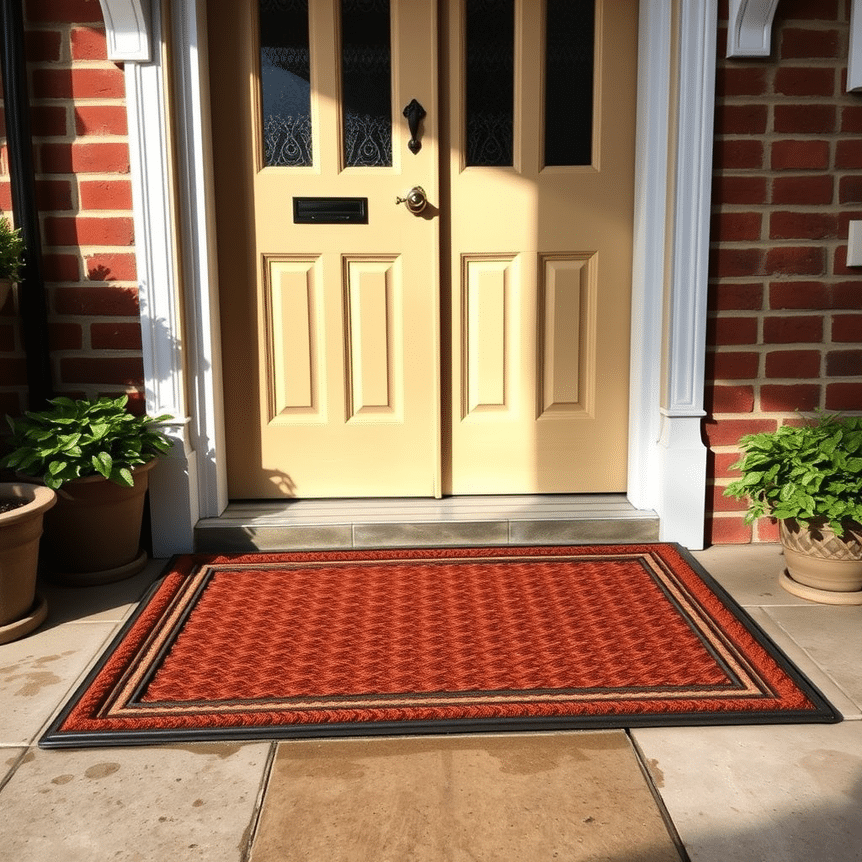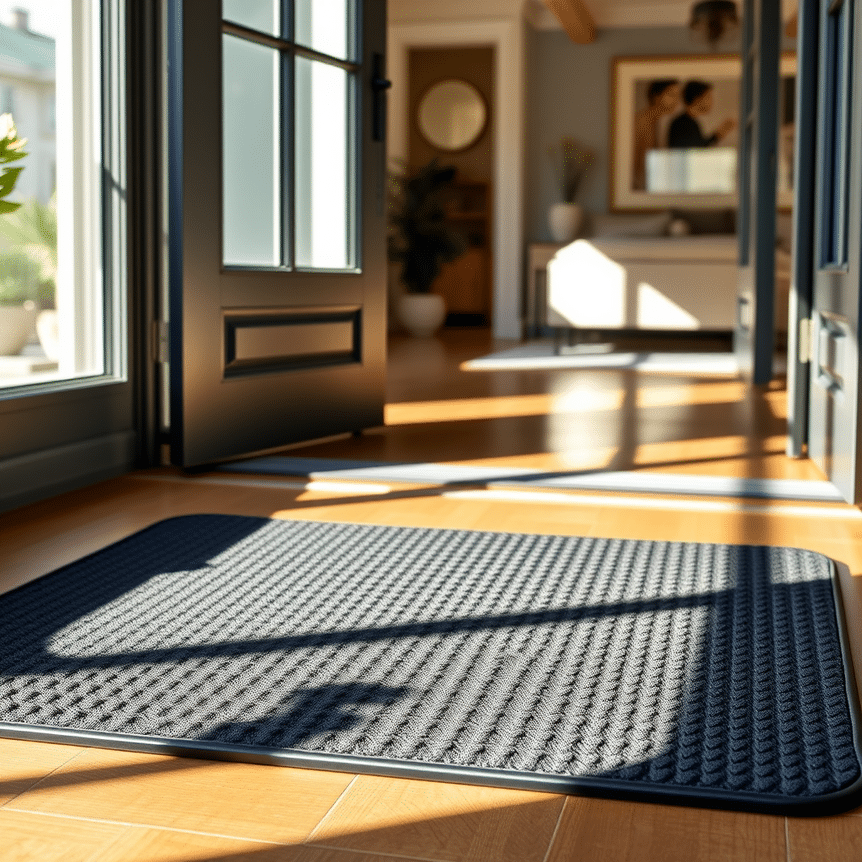Standing on cold, hard kitchen floors during a chilly British winter is a discomfort many UK homeowners know too well. A carefully selected Kitchen Runner Rug not only adds warmth and style but also acts as a protective barrier against spills, stains, and wear in one of the busiest zones of your home. Given that British households spend an average of 15 hours per week in their kitchens, choosing the right runner rug enhances both comfort and functionality, making it a pivotal element of any functional UK kitchen.
UK kitchens face particular challenges—from fluctuating seasonal humidity to the often-compact dimensions of city flats or traditional galley kitchens—making material choice crucially important. This guide will help you identify the best Kitchen Runner Rug materials, specifically designed to withstand the realities of British family life, ensuring exceptional durability, essential safety, and lasting aesthetic longevity. Discover how the right choice can transform your kitchen into a more comfortable and resilient space, protecting your flooring and enhancing your home’s busiest hub.
How Material Choice Influences Durability and Practicality in UK Kitchens
Kitchens in UK homes are dynamic environments, subject to unique environmental and usage factors that strongly influence a rug’s long-term performance and suitability:
-
- Heavy Foot Traffic: Kitchens receive about 25% more foot traffic than other rooms in a typical household. This constant movement demands materials that can endure consistent wear without quickly showing signs of deterioration, ensuring your rug remains a durable asset.
-
- Spill Vulnerability: With 72% of Brits cooking daily, kitchen rugs frequently encounter liquid and food spills. The chosen material must offer excellent stain resistance and be easy to clean to maintain hygiene and appearance.
-
- Cold Surfaces: Many UK homes, particularly older properties, lack underfloor heating, leaving kitchen floors cold. Rugs must provide effective insulation and comfort underfoot, making time spent in the kitchen more enjoyable.
-
- Humidity and Moisture: Coastal homes and the generally damp UK climate conditions introduce moisture challenges. Therefore, water-resistance is an important consideration to prevent mould, mildew, and material degradation.
Emma Roberts, a renowned UK interior stylist, notes, “The right kitchen runner rug material makes a huge difference, especially when most UK kitchens rely on cold laminate or tile floors. You want a solution that provides warmth and protection without compromising ease of cleaning or becoming a slip hazard. It’s about creating a practical yet inviting space.”
Comparing Top Kitchen Runner Rug Materials for UK Homes: Durability, Cleaning, and Comfort
Selecting the ideal kitchen runner rug material is paramount for UK homes, where practicality must meet style. Here’s a detailed comparison of the most popular options, helping you make an informed decision for your unique kitchen environment:
| Material | Durability & Wear | Water & Stain Resistance | Comfort & Feel | Cleaning Ease | UK Kitchen Suitability |
|---|---|---|---|---|---|
| Polyester | Good for high traffic; may mat in very heavy use. | Excellent stain resistance; vibrant colour retention. | Soft underfoot; can generate static in dry conditions. | Easy to vacuum; many machine washable options. | Highly practical for busy family kitchens, good value. |
| Polypropylene | Very durable; excellent resilience to crushing. | Naturally water-repellent; resists mould/mildew. | Soft to touch; can be light and easy to move. | Very easy to clean, can be hosed down outdoors. | Ideal for damp or high-humidity kitchens (e.g., coastal). |
| Woven Vinyl | Extremely durable; industrial-grade resilience. | Fully waterproof; resists all stains. | Firm, cushioned feel; can feel cold on bare feet. | Wipe clean or hose down. | Modern kitchens, high-spill areas, minimalist designs. |
| Cotton | Moderate; wears quicker in very high-traffic spots. | Absorbent; prone to staining if not treated. | Very soft and breathable. | Machine washable, but needs frequent cleaning. | Traditional or period kitchens; best for low-spill zones. |
| Jute & Sisal | Good durability; Sisal is more robust than Jute. | Highly absorbent; not water/stain resistant. | Jute is softer; Sisal is rougher, textured. | Spot clean only; prone to mould if wet. | Eco-friendly appeal; best in dry, low-traffic areas away from sinks. |
Polyester: The Practical UK Favourite for Everyday Use
Polyester Kitchen Runner Rugs have surged in popularity among UK homeowners and renters alike, largely due to their exceptional stain resistance and impressive affordability. They offer a winning combination of practicality and style, making them a top choice for busy household kitchens.
-
- Benefits: Polyester fibres inherently resist common kitchen stains—from accidental tea spills and jam splatters to robust sauces—with remarkable ease. They also maintain vibrant colour remarkably well, even in north-facing kitchens that receive less natural light, preventing fade over time. These durable rugs are compatible with standard UK vacuum cleaners for quick maintenance, and a wide array of options are available, ranging from budget-friendly choices to premium machine-washable designs, making them incredibly easy-clean kitchen rugs. For a highly durable and washable option, explore our range of heavy-duty kitchen runner rugs at Rugstars.
-
- Drawbacks: One minor consideration is their tendency to develop static electricity during particularly dry winter months. Additionally, lower-quality polyester may show signs of matting down over prolonged periods in very high-traffic areas, though higher-density weaves can mitigate this.
Polypropylene: The Humidity-Resistant Solution
Ideal for UK homes dealing with persistent dampness, especially those in coastal properties or older homes, polypropylene rugs combine ultimate practicality with impressive resilience. Often labelled as olefin, these synthetic rugs are a robust choice for kitchen environments where moisture is a concern.
-
- Benefits: Polypropylene naturally repels moisture and dries quickly, making it resistant to mould and mildew—a common issue in humid UK kitchens. They are lightweight and remarkably easy to move, which is a great advantage when redecorating or moving flats. Many designs expertly mimic the texture and appearance of more expensive natural fibres like jute or sisal but at a fraction of the price, offering a stylish yet cost-effective solution. Their exceptional durability also means they can be washed outdoors with a hose, avoiding any indoor mess.
-
- Drawbacks: Without proper backing, polypropylene rugs may become slippery on smooth kitchen flooring, posing a safety concern. It is crucial to ensure they have a quality non-slip backing or are paired with a good rug pad. They also have a relatively low melting point, making them unsuitable for placement too close to open flames or stove areas.
Many UK flats, particularly in cities like London, favour polypropylene kitchen runners for their fade resistance under strong sunlight and their ability to withstand the daily demands of urban living.
Woven Vinyl: Modern, Stylish, and Easy to Clean
Woven vinyl runners, popularised by brands like Chilewich, offer a perfect blend of modern industrial style and exceptionally low maintenance. They provide a unique textural element and are particularly well-suited for contemporary UK kitchens where sleek design meets practical functionality.
-
- Benefits: These kitchen mats are fully waterproof and incredibly easy to clean—a simple wipe or hose down outside is often all that’s needed. Their construction offers a subtle cushioning effect underfoot without absorbing spills or stains, making them a fantastic solution for active cooking zones. They are highly stylish, exceptionally durable, and well-suited to the demands of heavy kitchen use, providing excellent kitchen flooring protection.
-
- Drawbacks: While practical, woven vinyl can feel cold on bare feet during chilly British mornings, which might be a consideration for those who prefer softer textures. They also tend to be more limited in design styles and colours compared to textile-based runners, though their minimalist aesthetic often appeals to modern décor.
Cotton: Classic Comfort with Softness and Breathability
Cotton runners bring a timeless, traditional touch to British kitchens, often complementing period home aesthetics or creating a cosy, inviting atmosphere. Their natural fibres offer a comforting softness.
-
- Benefits: Cotton is incredibly soft and comfortable for prolonged cooking sessions or busy family mealtimes, providing a gentle surface underfoot. It is widely available and typically affordable, making it an accessible choice for many households. Its breathable construction is suitable for less humid kitchen areas where moisture\’s not a constant concern.
-
- Drawbacks: A key disadvantage is that cotton swiftly absorbs liquid, making stains more likely and potentially harder to remove if not addressed immediately. They demand more frequent washing to maintain hygiene and freshness, especially in a kitchen environment. Furthermore, cotton wears quicker in high-traffic locations compared to synthetic alternatives, requiring more frequent replacement or rotation.
Pro tip: Consider cotton blends that have been treated for stain resistance. These options strike an excellent middle ground by marrying the natural comfort of cotton with enhanced practicality for a kitchen setting.
Jute & Sisal: Eco-Friendly Natural Fibres with Unique Appeal
Natural fibres like jute and sisal offer a distinct rustic charm and organic texture, popular in British country and farmhouse styles. However, their use requires mindful placement in UK kitchens due to their specific properties.
-
- Benefits: These eco-friendly kitchen runner rug materials add a beautiful organic, textured look, which is highly popular in British country and farmhouse styles, as well as eco-conscious interiors. They are naturally insulating, helping to trap warmth on cold hard flooring, contributing to a more comfortable kitchen environment. Their environmental friendliness appeals greatly to green-conscious buyers seeking sustainable home décor solutions.
-
- Drawbacks: Their high absorbency makes them unsuitable for placement near sinks or any damp areas, as they can quickly absorb liquids, leading to stains and potential mould growth. They are also prone to mould and shedding if not properly maintained in dry conditions. Sisal is generally more durable than jute but can feel slightly rougher underfoot, which might be a consideration for those who prefer softer textures.
Interior expert James Mendelsohn recommends placing these natural fibre rugs away from wet zones: “Best for dry corners such as under breakfast bars, in dining alcoves, or in less trafficked areas where their aesthetic appeal can be appreciated without risk of damage.”
Key Features UK Buyers Must Prioritize for Kitchen Runner Rugs
Beyond material, several critical features significantly impact the performance and suitability of a kitchen runner rug in a UK home. Prioritising these ensures both safety and longevity.
Why Non-Slip Backing Is Essential for Kitchen Safety in the UK
With kitchen slips and trips accounting for nearly a third of all home accidents in the UK, a robust non-slip backing on your kitchen runner rug is not merely a recommendation—it’s a non-negotiable safety feature. Choosing rugs featuring:
-
- Rubberised, grip-enhancing undersides specifically designed to adhere securely to common UK kitchen flooring types such as tile, laminate, or vinyl.
-
- Textured backings or integrated non-slip layers that provide reliable friction, preventing unwanted movement.
-
- Avoid loose weaves without backing unless they are explicitly designed to be supplemented with high-quality, independent non-slip underlays, especially for high-traffic zones.
For renters, it’s advisable to confirm with landlords before using adhesive-backed rug pads to avoid any potential damage to the flooring beneath.
Selecting the Perfect Runner Size for UK Kitchen Layouts
The distinctive layouts of UK kitchens—particularly the prevalent galley styles found in 68% of homes—require precise sizing to ensure both functionality and aesthetic balance. When choosing your kitchen runner, consider these guidelines:
-
- Leave 15-20 cm (approximately 6-8 inches) of visible floor space at the runner’s edges. This not only allows for easier deep cleaning of the surrounding floor but also ensures a visually balanced and spacious feel.
-
- For L-shaped or segmented kitchens, consider using two smaller runners instead of attempting to fit one overly long, cumbersome rug. This approach offers greater flexibility, facilitates cleaning, and adapts better to complex layouts.
-
- Avoid wall-to-wall coverage. This practice can trap moisture, hinder proper air circulation underneath the rug, and make deep floor cleaning significantly more challenging. Runners should define areas, not obscure the entire floor.
Eco-Conscious Material Choices: Balancing Style and Sustainability
Sustainability is becoming an increasingly important purchasing criterion for 63% of UK consumers when selecting home décor. Choosing an eco-friendly kitchen runner rug not only benefits the planet but also adds a thoughtful dimension to your home. Look for options such as:
-
- Polyester runners made from recycled materials, giving new life to discarded plastics.
-
- Brands with transparent, eco-friendly manufacturing processes that minimise environmental impact.
-
- Companies that participate in rug take-back or recycling initiatives, actively working to prevent textile waste from ending up in landfills.
Supporting these sustainable practices allows you to furnish your home responsibly without compromising on style or functionality.
Step-by-Step Care & Maintenance Tips to Extend Your Rug’s Life in Busy UK Kitchens
Regular and appropriate care is crucial for extending the life of your kitchen runner rug, especially in such a high-activity area. Follow these tips to keep your rug looking its best:
-
- Daily: Vacuum with a soft brush attachment. This effectively removes crumbs, dust, and light debris without damaging the rug fibres, crucial for maintaining a clean and hygienic kitchen.
- Weekly: Quickly blot any spills immediately with a clean, damp microfiber cloth and a mild detergent. Always test the detergent on an inconspicuous area of the rug first to ensure it doesn’t cause discolouration. Swift action prevents stains from setting.
- Monthly: Rotate the rug 180 degrees. This simple step ensures even wear across high-traffic pathways, preventing specific areas from looking worn out prematurely.
- Seasonally: Deep clean your rug following the manufacturer’s guidelines. Some synthetic runners are conveniently machine washable, while others can be easily hosed down outdoors, offering a thorough refresh.
- Yearly: If your rug is reversible, flip it over. This can significantly refresh the surface wear and extend the rug’s overall lifespan, giving you more value from your investment.
Pro tip: Keep a dedicated cleaning cloth and a small bottle of mild, diluted detergent near your kitchen sink. This allows for quick and efficient spill responses during your busiest cooking days, preventing most stains from becoming permanent fixtures.
How to Confidently Select the Ideal Kitchen Runner Rug That Meets Your UK Needs
Choosing the perfect kitchen runner rug involves a careful balance of aesthetic appeal, practical needs, and specific considerations for UK homes. When making your final selection, weigh these key factors to ensure your rug is a lasting and valuable addition to your kitchen:
-
- Household Lifestyle: For busy homes with children and pets, materials like polyester and polypropylene are highly recommended. Their superior stain resistance and ease of cleaning mean they can handle daily spills and heavy foot traffic with minimal fuss, making them durable kitchen rugs that truly perform.
-
- Kitchen Humidity: If your kitchen is prone to dampness, perhaps due to its location in a coastal home or an older property, selecting moisture-resistant polypropylene or woven vinyl runners is crucial. These materials are designed to repel water and prevent mould and mildew growth, ensuring longevity.
-
- Style and Period Property: For traditional British kitchens or period properties, cotton blends or natural fibres like jute (placed away from moisture-prone areas) can beautifully complement the existing décor. They add a touch of classic comfort and warmth, enhancing the authentic charm of your home.
-
- Safety: Never compromise on non-slip backing. This feature is paramount to preventing accidents in the kitchen, where slips and trips are common. Always ensure your chosen rug has an integrated non-slip layer or pair it with a high-quality non-slip underlay for maximum security.
At Rugstars, we offer a curated selection of heavy-duty kitchen runner rugs, meticulously tested for durability and style demands of UK homes. Our expert guidance helps ensure your chosen kitchen rug isn’t just a decorative accent—it’s a long-term functional asset that adds essential warmth, enhances safety, and provides resilient protection to your busiest home space. Invest in a kitchen runner that truly stands up to the demands of British family life.
A well-chosen Kitchen Runner Rug is much more than mere décor; it’s a practical and thoughtful investment tailored to Britain’s unique kitchen environments. By prioritising the right materials, essential safety features, and easy maintenance, you can transform your kitchen into a more comfortable, safer, and more stylish heart of your home. Elevate your kitchen experience today with durable, comfortable, and stylish runners made to last through countless British family meals and gatherings, providing both aesthetic beauty and functional resilience for years to come.
Frequently Asked Questions (FAQ) About Kitchen Runner Rugs
-
1. What are the best materials for a kitchen runner rug in a UK home?
- For UK kitchens, the best materials are often synthetics like polyester and polypropylene due to their excellent stain resistance, durability, and ease of cleaning, especially for high-traffic and spill-prone areas. Woven vinyl is also highly practical for modern kitchens due to its waterproof nature. While cotton and natural fibres like jute or sisal offer comfort and style, they are generally better suited for drier, less trafficked kitchen zones.
-
2. How important is non-slip backing for a kitchen runner rug?
- Non-slip backing is absolutely essential for kitchen runner rugs in the UK. Kitchens are high-traffic areas prone to spills, and a rug without a secure backing can easily slip, leading to accidents. Look for rugs with rubberised or textured undersides, or use a high-quality non-slip rug pad, to ensure maximum safety on tile, laminate, or vinyl floors.
-
3. Are kitchen runner rugs easy to clean and maintain?
- The ease of cleaning depends significantly on the material. Synthetic rugs like polyester and polypropylene are generally very easy to clean, with many being machine-washable or hose-washable outdoors. Woven vinyl can simply be wiped down. Cotton rugs are machine washable but require more frequent cleaning due to their absorbency. Natural fibre rugs like jute and sisal are typically spot-clean only and not suitable for wet cleaning, requiring more careful maintenance.
-
4. Can I use natural fibre rugs like jute or sisal in my UK kitchen?
\n
- While jute and sisal offer an attractive, eco-friendly aesthetic, they are generally not ideal for all areas of a UK kitchen. They are highly absorbent and prone to mould and mildew in damp conditions, making them unsuitable near sinks or high-spill zones. They are best placed in drier, lower-traffic areas, such as under a breakfast bar or in a kitchen dining alcove, to enjoy their natural charm without practical drawbacks.
-
5. How do I choose the right size kitchen runner for a UK galley kitchen?
- For common UK galley kitchens, precise sizing is key. Aim to leave approximately 15-20 cm (6-8 inches) of visible floor space on all sides of the runner. This provides a clean aesthetic, allows for easier floor cleaning, and ensures the rug doesn’t feel cramped or obstruct movement. For L-shaped or segmented kitchens, consider using two smaller runners for better flexibility and flow.



